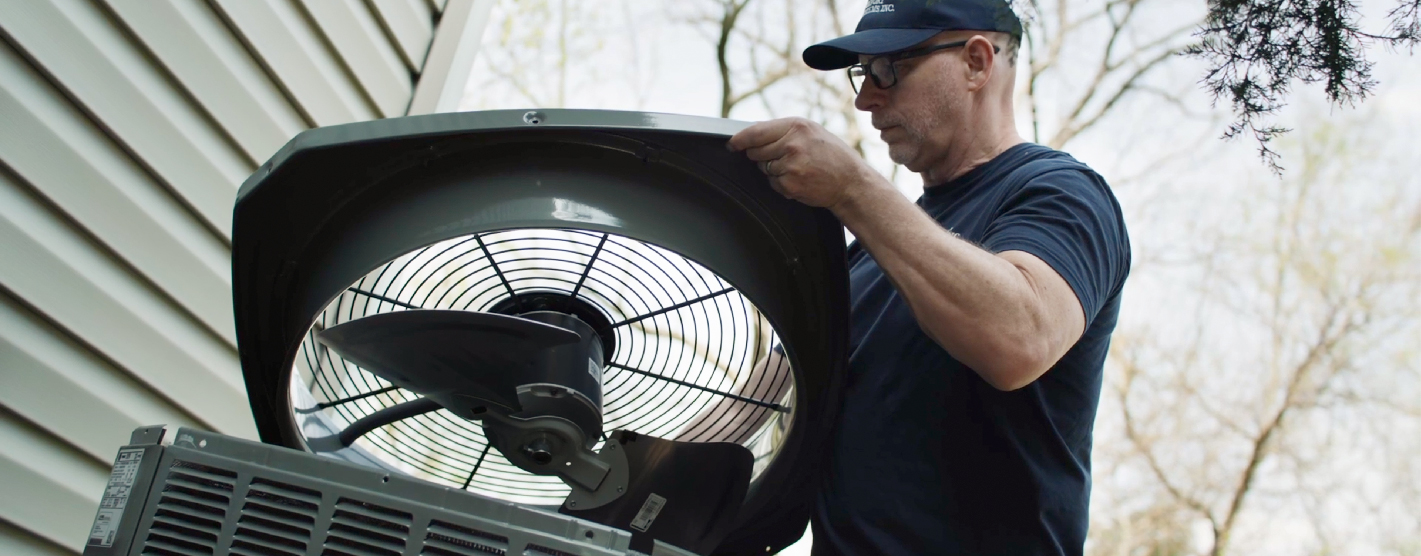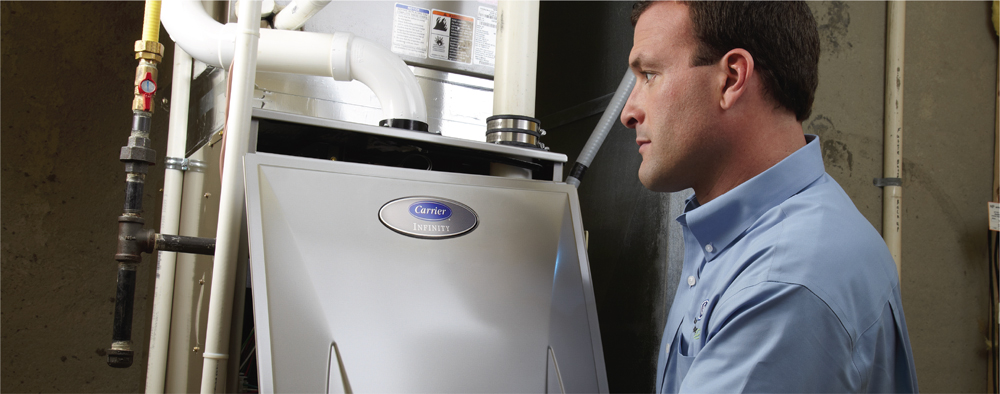HVAC systems are the unsung heroes of our homes, keeping us cool in the summer, warm in the winter, and comfortable year-round. We only tend to think about them when they aren’t working. Like any complex system, they require regular maintenance and occasional repairs to function at their best. Understanding the essential aspects of HVAC repair, focusing on air conditioners, furnaces, and heat pumps, will help you prepare for times when you need service. If you are in immediate need of HVAC services, contact us right away.
AIR CONDITIONER REPAIRS
WHAT YOU NEED TO KNOW ABOUT AIR CONDITIONER REPAIRS
Air conditioners are intricate systems crafted to keep our homes comfortable by regulating indoor temperatures. Over time, the various components within an air conditioner can wear out or malfunction, making repairs necessary. Understanding the high-level aspects of air conditioner repairs can help homeowners maintain their systems more effectively and know when it’s time to call in the pros. Let’s look at some common issues, signs indicating repairs are needed, and the general repair process.

SIGNS YOU NEED AC REPAIR
Inadequate Cooling: If your air conditioner is running but not cooling your home effectively, it might be struggling with low refrigerant levels, dirty coils, or a failing compressor. Low refrigerant means the system can’t absorb heat efficiently, while dirty coils impede heat exchange. Compressor issues, on the other hand, are more severe and typically require professional repair to restore effective cooling.
Unusual Noises: Strange noises like grinding, squealing, or banging are clear signs that something’s amiss inside your air conditioner. Grinding noises often indicate problems with the motor bearings, while a worn-out belt can cause squealing. Banging noises usually mean something is loose or broken, such as a connecting rod, piston pin, or crankshaft. You should investigate these sounds promptly to prevent further damage.
Frequent Cycling: When your air conditioner turns on and off frequently, known as short cycling, it can be due to an oversized unit, thermostat issues, or airflow problems. Short cycling not only prevents the system from effectively cooling your home but also increases wear and tear on the components. Frequent cycling can lead to more frequent repairs and a shortened lifespan for your system, so it’s important to address the underlying cause quickly.
High Energy Bills: A sudden spike in your energy bills often indicates that your air conditioner is working harder than it should be. This inefficiency can stem from dirty filters that block airflow, low refrigerant levels that make the system work overtime to cool, or failing components that reduce overall efficiency. Addressing these issues can help restore your system’s efficiency and reduce your energy costs.
Water Leaks: Any visible water around the air conditioning unit could indicate a clogged drain line or other drainage issues. Clogged drain lines can cause water to back up and leak, potentially leading to water damage and mold growth. Promptly addressing water leaks helps prevent these problems and keeps your system running smoothly.
THE REPAIR PROCESS
When you call in a professional HVAC technician for air conditioner repairs, they typically do the following:
1. Initial Inspection: Technicians begin with a comprehensive unit inspection to diagnose the problem. A diagnosis involves checking refrigerant levels, electrical connections, filters, and other components to pinpoint what’s wrong.
2. Diagnosis and Recommendations: The technician will explain the problem and recommend the necessary repairs after identifying the issue. They will also estimate the repair costs, giving you a clear idea of what’s needed to fix your system.
3. Repair Work: Depending on the diagnosis, the repair work can range from simple tasks like replacing filters or clearing drain lines to more complex procedures such as fixing refrigerant leaks or replacing electrical components. Each repair is tailored to address the specific problem identified during the inspection.
4. Testing and Calibration: Once the repairs are complete, the technician will test the system to ensure it operates correctly. They will also calibrate the thermostat and other settings to optimize performance, ensuring your home stays comfortable.
5. Preventive Maintenance Advice: The technician will offer preventive maintenance tips to help you avoid future issues. The tech may advise you on regular filter changes, keeping the area around the outdoor unit clear, and scheduling semi-annual professional maintenance checks. Following these recommendations can extend the lifespan of your air conditioner and keep it running efficiently.
Furnace Repairs

WHAT YOU NEED TO KNOW ABOUT FURNACE REPAIR
Furnaces are essential for keeping our homes warm and comfortable during the colder months. Over time, various furnace components can wear out or malfunction, necessitating repairs. Understanding the high-level aspects of furnace repairs can help homeowners maintain their systems more effectively and know when to call in professional help. Let’s explore common issues, signs that repairs are needed, and the repair process
5 SIGNS FURNACE REPAIRS ARE NEEDED
1. Inadequate Heating: If your furnace is running but not heating your home effectively, it might be dealing with issues like a faulty thermostat, clogged filters, or burner problems. When the thermostat malfunctions, it can’t communicate properly with the furnace to maintain the set temperature. Clogged filters restrict airflow, and dirty burners can prevent the furnace from igniting efficiently, leading to insufficient heating.
2. Unusual Noises: Strange noises such as banging, rattling, or squealing coming from your furnace can indicate mechanical issues or loose components. Banging noises often signal problems with the ignition system or burners, while rattling could mean loose panels or parts. Squealing noises typically indicate issues with the blower motor or belts, which you should address promptly to prevent further damage.
3. Frequent Cycling: If your furnace turns on and off frequently, it could be due to an oversized unit, a malfunctioning thermostat, or airflow issues. Frequent cycling, or short cycling, prevents the system from maintaining a consistent temperature and increases wear and tear on the components. Short cycling can lead to more frequent repairs and a shortened lifespan for your furnace, so it’s essential to address the underlying cause quickly.
4. High Energy Bills: A sudden increase in energy bills often indicates that your furnace is working harder than it should be. This inefficiency can stem from dirty filters that block airflow, issues with the thermostat, or failing components that reduce overall efficiency. Addressing these issues can help restore your system’s efficiency and lower energy costs.
5. Pilot Light or Ignition Problems: If the pilot light or ignition system malfunctions, the furnace may not light properly or stay lit. A flickering or yellow pilot light indicates a problem, as it should be steady and blue. Issues with the pilot light or ignition can prevent the furnace from operating correctly, requiring immediate attention to ensure safe and efficient heating.
THE FURNACE REPAIR PROCESS
When professional HVAC technicians are called in for furnace repairs, here’s what you may expect:
1. Initial Inspection: Technicians begin with a comprehensive furnace inspection to diagnose the problem. The inspection involves checking the thermostat settings, examining electrical connections, inspecting the burners, and ensuring that all components are functioning properly.
2. Diagnosis and Recommendations: The technician will explain the problem and recommend the necessary repairs after identifying the issue. They will also estimate the repair costs, giving you a clear idea of what’s needed to fix your system.
3. Repair Work: Depending on the diagnosis, the repair work can range from simple tasks like replacing filters or cleaning burners to more complex procedures such as repairing the ignition system or replacing electrical components. Each repair addresses the specific problem identified during the inspection.
4. Testing and Calibration: The technician will test the system once the repairs are complete to ensure it is operating correctly. They will also calibrate the thermostat and other settings to optimize performance, ensuring your home stays warm and comfortable.
5. Preventive Maintenance Advice: Finally, the technician will offer advice on preventive maintenance to help you avoid future issues. Tips include regularly changing the filter, keeping the area around the furnace clear, and scheduling semi-annual professional maintenance checks. Following these recommendations can extend the lifespan of your furnace and keep it running efficiently.
HEAT PUMP REPAIRS

WHAT HOMEOWNERS SHOULD KNOW ABOUT HEAT PUMP REPAIRS
Heat pumps are versatile systems that provide both heating and cooling for our homes, making them a valuable asset year-round. However, like any HVAC system, they can experience wear and tear over time, leading to the need for repairs. Understanding the high-level aspects of heat pump repairs can help homeowners maintain their systems more effectively and know when to call professional help. Here’s an overview of common issues, signs that repairs are needed, and the repair process.
RECOGNIZING THE SIGNS OF NEEDED REPAIRS
1. Inadequate Heating or Cooling: If your heat pump is running but not adequately heating or cooling your home, it could indicate problems such as low refrigerant levels, dirty coils, or issues with the compressor. Low refrigerant can result from leaks, reducing the system’s efficiency. Dirty coils impede the process of heat exchange. Compressor issues are serious and often require professional intervention.
2. Unusual Noises: Strange noises like grinding, squealing, or rattling coming from your heat pump can indicate mechanical issues or loose components. Grinding noises might suggest motor problems, squealing could be due to a worn-out belt, and rattling may indicate loose parts. Addressing these noises early on can prevent further damage and more costly repairs down the line.
3. Frequent Cycling: If your heat pump turns on and off frequently, known as short cycling, it could be due to an oversized unit, thermostat issues, or airflow problems. Short cycling not only prevents the system from maintaining a consistent temperature but also increases wear and tear on the components. Because frequent cycling can lead to more frequent repairs and a shortened lifespan for your heat pump, it’s important to address the underlying cause quickly.
4. High Energy Bills: A sudden increase in energy bills often signals that your heat pump is working harder than it should be. This inefficiency can stem from dirty filters that block airflow, low refrigerant levels that make the system work overtime, or failing components that reduce overall efficiency. Addressing these issues can help restore your system’s efficiency.
5. Ice Buildup: Ice buildup on the outdoor unit of your heat pump can indicate problems with airflow, refrigerant levels, or the defrost cycle. Ice can block the coils and prevent the system from heating effectively. Regularly checking for ice buildup and promptly addressing it can avoid damage to the system and ensure efficient operation.
THE HEAT PUMP REPAIR PROCESS
When a professional HVAC technician arrives for heat pump repairs, they typically follow a systematic approach:
1. Initial Inspection: Technicians start with a comprehensive heat pump inspection to diagnose the problem. The inspection may involve checking refrigerant levels, electrical connections, filters, and other components to pinpoint what’s wrong. They will also look for signs of wear and tear or damage that could be causing the issue.
2. Diagnosis and Recommendations: The technician will explain the problem and recommend the necessary repairs after identifying the issue. They will also provide an estimate of the repair costs, giving you a clear idea of what’s needed to fix your system. Understanding the diagnosis and recommended repairs can help you make informed decisions about your heat pump.
3. Repair Work: Depending on the diagnosis, the repair work can range from simple tasks like replacing filters or clearing drain lines to more complex procedures such as fixing refrigerant leaks or replacing electrical components. Each repair will address the specific problem identified during the inspection.
4. Testing and Calibration: The technician will test the system once the repairs are complete to ensure it is operating correctly. They will also calibrate the thermostat and other settings to optimize performance, ensuring your home stays comfortable in both heating and cooling modes.
5. Preventive Maintenance Advice: Finally, the technician will offer advice on preventive maintenance to help you avoid future issues. Preventive maintenance recommendations often include tips on regular filter changes, keeping the area around the outdoor unit clear, and scheduling annual professional maintenance checks. Following these recommendations can extend the lifespan of your heat pump and keep it running efficiently.
